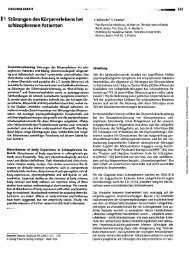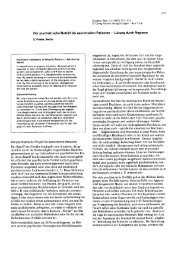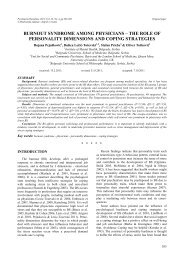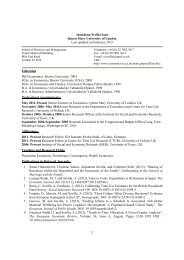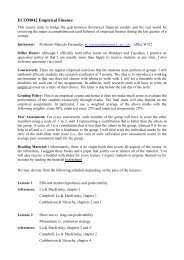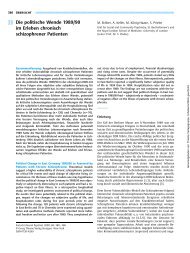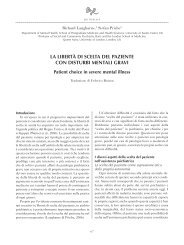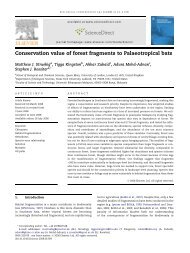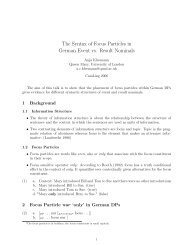Proofs - Personal Webspace for QMUL - Queen Mary, University of ...
Proofs - Personal Webspace for QMUL - Queen Mary, University of ...
Proofs - Personal Webspace for QMUL - Queen Mary, University of ...
Create successful ePaper yourself
Turn your PDF publications into a flip-book with our unique Google optimized e-Paper software.
generating a model <strong>of</strong> the self within such neuronal structures.<br />
They suggest that the orbitomedial prefrontal cortex (OMPFC)<br />
accounts <strong>for</strong> the continuous representation and refl ection <strong>of</strong><br />
self- referential inputs from the body and the environment [4].<br />
Once represented in the OMPFC, self- referential in<strong>for</strong>mation<br />
appears to be monitored in the supragenual anterior cingulate<br />
cortex and evaluated in the dorsomedial prefrontal cortex [45].<br />
These functions might be complemented by the integration <strong>of</strong><br />
this in<strong>for</strong>mation in the emotional and autobiographical context<br />
<strong>of</strong> one’s own person; this latter function may be related to the<br />
posterior cingulate cortex.<br />
Whereas philosophers aim at defining a coherent and<br />
differentiated concept <strong>of</strong> the self, neuroscientists address<br />
questions like the following: How can we study self- related<br />
mental processes empirically, i.e. how can we reliably operationalize<br />
self- related processes? What are the neural correlates<br />
<strong>of</strong> self- related mental processes? A typical example <strong>for</strong> such<br />
an operationalization is a functional magnetic resonance<br />
imaging (fMRI) study by Kelley and colleagues [33]. In this<br />
study, participants were asked to judge trait adjectives (<strong>for</strong><br />
example, “polite”) as to whether they properly described<br />
the participants themselves (self- referential), the current US<br />
president (other- referential), or a given case (case- referential).<br />
Comparing the self- referential trials with the other- referential<br />
and case- referential trials allowed identifying brain areas<br />
particularly associated with self- referential processing. In this<br />
experiment, effects were observed in the above mentioned<br />
cortical midline structures. Like most, if not all, neuroimaging<br />
studies <strong>of</strong> the self, this experiment does not examine the self<br />
per se, but rather self- referential stimulus processing. Although<br />
study participants need to have a coherent model or construct<br />
<strong>of</strong> their own self (which is in some way composed <strong>of</strong> individual<br />
experiences, beliefs, preferences, and capacities) to per<strong>for</strong>m the<br />
task, the experiment does not explicitly focus on this model.<br />
Instead, the experiment examines how this model is implicitly<br />
used by the study participant to judge the self- referentiality <strong>of</strong><br />
the trait adjectives presented.<br />
Self- referential processing is a heterogeneous process,<br />
entailing a complex set <strong>of</strong> operations. Consequently, a large<br />
series <strong>of</strong> experiments is needed to identify the neural correlates<br />
underlying the specifi c subprocesses. On the one hand, these<br />
studies aim at disentangling self- referential processing from<br />
closely related processes, such as emotion processing [47], episodic<br />
memory [49], theory <strong>of</strong> mind [62], reward processing [19]<br />
and realness [57]. On the other hand, these studies examine<br />
self- referential processing in different domains. Besides the<br />
above mentioned personal trait judgement, these domains<br />
concern the centeredness <strong>of</strong> an individual’s multidimensional<br />
and multimodal space upon one’s body [63], the recognition<br />
<strong>of</strong> one’s own face [35], the experience that one’s own body<br />
and environment are perceived as closely related to one’s own<br />
self (ownership [11]), the feeling <strong>of</strong> being causally involved<br />
in an action [17], and the perception <strong>of</strong> signals <strong>of</strong> one’s own<br />
body, e.g., heart beat [9]. Evidently, these domains <strong>of</strong> selfreferential<br />
processing concern both automatic, pre- refl ective<br />
self- awareness and higher- order conscious self- refl ection.<br />
Strikingly, self- referential processing across these different<br />
domains consistently activates the cortical midline structures<br />
and connected subcortical brain areas [46].<br />
A. Heinz et al. / European Psychiatry 27 (2012) / supplement n°2 / S32-S43 S41<br />
The concept <strong>of</strong> the embodied self draws on the idea that<br />
the human self model is based on the continuous processing<br />
<strong>of</strong> internally generated inputs. At the physiological level, this<br />
continuous self- referential process may correspond to the high<br />
level <strong>of</strong> neural activity found in the cortical midline structures<br />
and connected subcortical areas during so- called resting conditions,<br />
such as viewing a blank screen [45]. This high level <strong>of</strong><br />
neural activity at “rest” (i.e., in the absence <strong>of</strong> externally- oriented<br />
tasks) has been characterized as the “physiological baseline” or<br />
“default mode” <strong>of</strong> the brain [20]. Given this high baseline activity,<br />
it comes as no surprise that cortical midline structures are mainly<br />
modulated by deactivation during non- self- referential tasks. This<br />
deactivation might refl ect the temporary eclipse <strong>of</strong> subjective<br />
experience during tasks with externally- oriented cognitive and<br />
behavioral demands.<br />
Although self- referential processing involves pre- refl ective,<br />
continuous, internally- directed processes, recent neuroimaging<br />
studies suggest a strong infl uence <strong>of</strong> social interaction<br />
and culture on these processes. Support <strong>for</strong> the link between<br />
self- referential processing and social interaction comes from<br />
neuroimaging studies showing a striking overlap between brain<br />
areas involved in referring to one’s own actions, sensations and<br />
emotions (and to those <strong>of</strong> others. So why are similar brain areas<br />
“used” <strong>for</strong> these two processes that seem to differ so much at<br />
fi rst glance? On the one hand, activation <strong>of</strong> the self- network<br />
during social cognition may refl ect simulations that translate<br />
the bodily, emotional and mental states <strong>of</strong> others into the<br />
neural language <strong>of</strong> our own states [34]. According to simulation<br />
theory, such simulations are used by humans to understand<br />
others’mental states. On the other hand, the pre- refl ective as<br />
well as the self- conscious relationship to one’s own bodily,<br />
emotional and mental states seems to be established (phylogenetically<br />
and ontogenetically) through social interaction. We<br />
seem to “learn” about such states through prelingual and lingual<br />
communication about these states when they occur in oneself<br />
or the other [58].<br />
Recent transcultural neuroimaging studies have demonstrated<br />
that one’s cultural background can infl uence the neural<br />
activity that underlies self- referential processing [21]. Similar<br />
to the above- mentioned study by Kelley and colleagues [33],<br />
a fMRI study from China [65] measured brain responses while<br />
study participants judged personal trait adjectives regarding<br />
“self”, “mother” or “a public person” and compared selfreferential<br />
processes between Western and Chinese subjects.<br />
In both groups, the medial prefrontal cortex and anterior<br />
cingulate cortex showed stronger activation in self- compared<br />
to other- judgements. In addition, mother- judgements (relative<br />
to other- judgements) activated the medial prefrontal cortex<br />
in Chinese but not in Western study participants. The authors<br />
suggest that these fi ndings might refl ect two distinct types <strong>of</strong><br />
self- representation, namely a “Western independent” type <strong>of</strong> self<br />
versus an “East Asian interdependent” type <strong>of</strong> self [65]. These<br />
fMRI fi ndings demonstrate how neuroimaging can be used to<br />
distinguish culture- sensitive from culture- invariant neural<br />
mechanisms <strong>of</strong> self- referential processing.<br />
Another cross- cultural fMRI study by Chiao and coworkers<br />
[8] focused on the infl uence <strong>of</strong> so- called individualistic versus<br />
collectivistic views on self- referential processing. Starting point<br />
<strong>of</strong> the study was the rough and preliminary distinction between<br />
<strong>Pro<strong>of</strong>s</strong>




